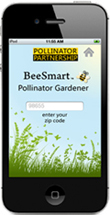Support Pollinators on Your Lands: Best Management Practices and Planting Guides for Roadsides, Utility Corridors, and Farms on Southern Ontario
Managed landscapes can offer critical pollinator support, especially if they are managed using techniques and practices that are known to support pollinators. This set of technical guides presents farmers, roadside managers, and utility corridor managers with tools, tips, and information on how they can manager their lands to benefit pollinators. Each landscape is unique but the same principles apply. These three steps that will make a difference:
- Plant or seed native wildflowers to feed the bees and other pollinators
- Use an Integrated Vegetation or Pest Management approach to weed and pest issues
- Assess and monitor your landscape to support our understanding of pollinators
Planting the right plants helps support pollinators
Pollinators don’t see property lines or field boundaries and they don’t consider municipal or political jurisdictions; their occurrence is dictated by local plant communities, climate, and environmental history. In Southern and Southeastern Ontario there are five different Ecoregions: The St. Lawrence Lowlands, Frontenac Axis, Lake Erie Lowlands, Manitoulin-Lake Simcoe and Algonquin-Lake Nippissing. EcoRegional planting lists for each landscape type across these five EcoRegions area available for you to help select your plants that support pollinators. To see a list of plants that you might consider enter your postal code and click on the landscape type you are working in.
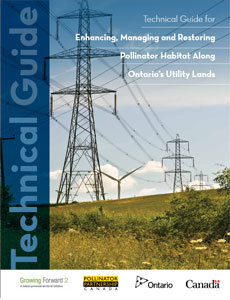
Utility Corridors
In Ontario, right-of-way (ROW) areas related to utility corridors constitute vast tracts of land that are ideal for creating and managing pollinator-friendly landscapes. There is well over 36,000 hectares of public land associated with the network of transmission and distribution lines stewarded by various utility companies who provide electrical and hydrocarbon energy transmission and distribution.
English DownloadEN FRANÇAIS
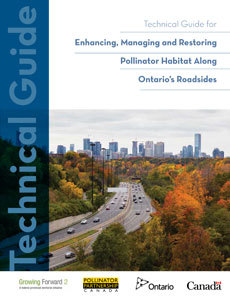
Roadsides
With over 16,000 km of roads in Ontario, marginal habitats such as roadsides are a significant, yet often overlooked, resource for pollinator conservation. In landscapes fragmented by urbanization and agriculture, roadsides are an increasingly important component of regional habitat networks and connectivity. They can support native vegetation, create important habitat for wildlife, and may support the pollination needs of neighbouring farms.
English DownloadEN FRANÇAIS
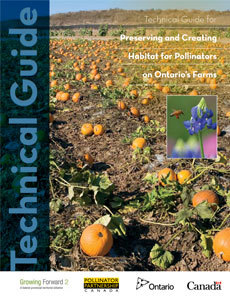
Farms
Farmland is critical for pollinators because it provides the open areas and diverse patches of plants they need. In Ontario pollinators support the production of apples, peaches, tomatoes, cherries, pears, soybean, blueberries, squash and pumpkin throughout the province adding up to nearly 400 million dollars of production each year. By protecting the habitat you already have, creating new habitat and reducing the unwanted impacts of some farm practices, you can help pollinators.
English DownloadEN FRANÇAIS
Establishing goals to secure habitat for pollinators is an essential strategy. These flower-visiting animals are a truly diverse group with some pollinator species having unique habitat requirements. Understanding the unique biology and needs of each pollinator type allows us to more effectively protect, restore, and enhance habitat. Ontario, through the creation of a Pollinator Health Strategy, is taking action to strengthen pollinator health and ensure healthy agricultural and natural ecosystems. The program focuses on regulating the use of neonicotinoid-treated seed and the development of a comprehensive Pollinator Health Action Plan to address multiple stressors on pollinators. To learn more about what the province is doing and how you may contribute, visit https://www.ontario.ca/.
Land Manager Guide Infographic for Download
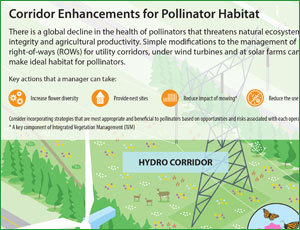
Corridor Enhancements for Pollinator Habitat
English DownloadEN FRANÇAIS
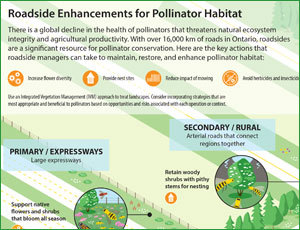
Roadside Enhancements for Pollinator Habitat
English DownloadEN FRANÇAIS
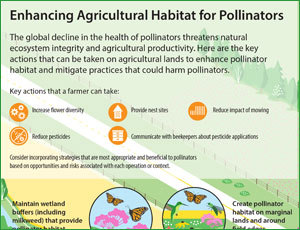
Enhancing Agricultural Habitat for Pollinators
English DownloadEN FRANÇAIS
